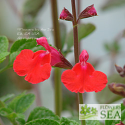 | Drought tolerance is characterized by a plant's ability to get by on less water. Yet native climate often defines the boundaries of this trait. The plants in this list all share the ability to grow in arid conditions when water is scarce. A plant that tolerates and perhaps thrives on less than 15 inches of annual rain may be overwhelmed by moisture in a state where drought lowers the annual average from 50 to 40 inches. But Flowers by the Sea also gladly provides information if you ask about Salvias and companion plants that are appropriate for drought in damper parts of the nation. One definition of drought is a below-average amount of rain and snow over an extended period, such as during more than one growing season. Yet drought is caused by more than a shortfall of local precipitation. Even if your areaâs seasonal average of moisture is at a historically normal level, the level in another region may not be. If waterways and dams connect the two regions -- such as in the American West -- low river levels can mean decreased water storage and drought for both areas. Furthermore, if your regionâs population is growing but its water supply isnât, that can also lead to drought due to insufficiency. This adds up to a web of trouble that can only be untangled through water conservation. One effective conservation measure is to design gardens with plants that are attractive yet need little water. These are called xeriscapes, waterwise landscapes and dry gardens. Drought tolerance is closely connected to the term "xeric," a Greek word for "dryâ and the root of xeriscape. Xeriscapic plants include species accustomed to arid climates or dry summer/wet winter growing conditions, such as along coastlines with Mediterranean climates. The Salvias and companion plants in this list share the ability to grow when water is scarce. They are attractive even while surviving minimal summer water. Many are native to arid regions or are from Mediterranean climates. Before ordering plants, please carefully consider your local growing conditions in order to select species that will be right for your climate and yard. We're happy to provide recommendations. |
(Elk Xanadu Jame Sage) Like the magical, fictional land of Xanadu, there’s something heavenly about this sage. The flowers of Salvia x ‘Elk Xanadu’ look ethereal due to the bluish cast of their magenta-pink blossoms supported by deep magenta and green calyxes. It's a powerful attraction for pollinators, including hummingbirds.
(Gayle Nielson Hybrid Sage) Whorl-like clusters of violet-blue flowers on slender stems as well as its height and width indicate that Gayle Nielson Hybrid Sage is related to some form of Salvia clevelandii.
(John Whittlesey Sage) Hardy, vigorous and long blooming, John Whittlesey Sage is a hybrid of D'Arcy's Sage (Salvia darcyi) -- a native of Mexico -- and Mountain Sage (S. microphylla), which is native to the American Southwest and Mexico.
(Majestic Pink Sage) Very large richly colored hot pink blossoms and broad, glossy, intricately textured leaves are part of what makes Salvia x 'Majestic Pink' a standout. This is a complex hybrid involving several Salvia species from the ongoing breeding program at FBTS.
(Cherry Red Mountain Sage) This isn't just another red sage. Brilliant cherry-red flowers with dark purple bracts and cold weather tolerance to USDA Zone 6 make this a valuable landscaping plant.
(Nuevo Leon Hybrid Sage) Imagine tiny, smooth, green leaves and deeper lavender-blue flowers than those of Salvia lycioides x greggii 'San Isidro'. With its midnight purple flowers, Nuevo Leon is a dramatic Salvia greggii hybrid.
(Purple Stem Sage) Deep purple stems and cobalt blue flowers with pronounced white beelines and dusky gray calyxes cause this sage to command attention.
(Scarlet Spires Sage) This is a brilliant cross between the sturdy D'Arcy's Sage (Salvia darcyi) and the beautifully colored 'Raspberry Delight' Littleleaf Sage (Salvia microphylla 'Raspberry Delight').
(Starlight Sage) Add sparkle to your dry garden with the pale pastel flowers of this hybrid of two Southern California native plants often seen growing together in the wild — Black Sage (Salvia mellifera) and White Sage (Salvia apiana). Salvia x 'Starlight' is a shrub that blooms early and long, attracting honeybees but not deer.
(Waverly Sage) A pale pink to lavender blush adds delicate color to the white flowers of Waverly Sage, which are supported by plum-colored calyxes. Its mid-green leaves are lance shaped and veined.
(Dyson's Orangy Pink Hybrid Jame Sage) Many Salvia x jamensis hybrids remind gardeners of sunrise, such as Dyson's Orangy Pink. Light green calyxes faintly striped with red cup its luminous pale salmon pink blossoms with creamy throats.
(Shell Dancer Sage) So many sages combine resilience and loveliness. This includes Salvia 'Shell Dancer', which withstands heat and drought yet has delicate looking blossoms and lush green foliage.
(Tangerine Ballet Hybrid Jame Sage) Soft pinkish-orange flowers with contrasting yellow eyes make this Jame Sage look as tasty as sorbet. Hardy to at least 10 degrees F, Tangerine Ballet is also heat tolerant, drought resistant and long blooming-- all marks of Salvias in the closely related Autumn and Mountain Sage group.
(Yellow Pink Hybrid Jame Sage) Dusty pink with pale yellow throats, the bicolor pastels of this Salvia x jamensis are especially charming up close. 'Yellow Pink' is a compact sage with tiny, smooth foliage.
(Rocketman Russian Sage) A cloud of cool, lavender-blue flowers shoot upward from the fine-leafed, gray-green foliage of Salvia yangii ‘Rocketman’. This is a shorter, more upright form of Russian Sage, which was known botanically as Perovskia atriplicifolia until 2019 when the species was reclassified as a Salvia.























